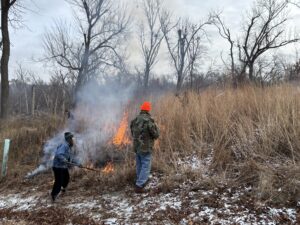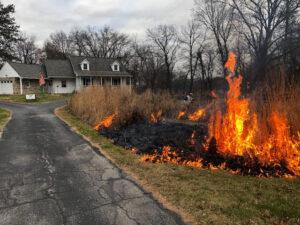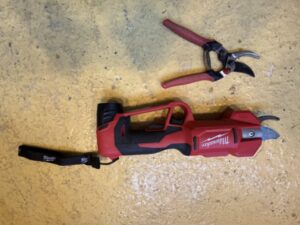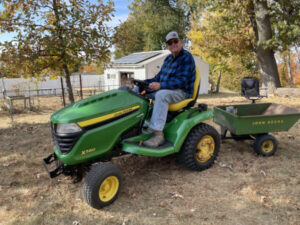by Winding Pathways | Jul 3, 2025 | (Sub)Urban Homesteading, Flowers/Grasses, Foraging, Garden/Yard, Pests
A Variation on “The Four Horsemen”
A quartet of deadly and toxic plants lurks along trails and riverbanks in Iowa and some across much of the world. They are Poison Hemlock, Poison Ivy, Flowering Spurge, and Wild Four O’clock.
Poison Hemlock
We’ll start with Poison Hemlock. Socrates wasn’t the only person killed by it. The Greeks once used to execute criminals.
Poison hemlock isn’t related to the majestic hemlock tree. Rather, it’s a biennial herbaceous plant. In its second year it quickly shoots up to tower upwards of eight feet tall. In Iowa it prefers living in dappled sunlight where the soil is moist. That describes the land bisected by public trails paralleling rivers and streams—places where people go to recreate.
It’s deadly poisonous, but only when ingested. Walking or cycling by it creates no problem at all. But it’s wise to know about this potentially deadly plant. All parts of it are toxic to people and animals when ingested. Even dried, wintery stems are poisonous.
By early June, the tall green plants with feathery leaves begin bearing white clusters of flowers. Their prettiness is deadly.
Poison hemlock could be confused with Queen Anne’s Lace that’s sometimes called wild carrot. Poison hemlock also often lives near wild parsnips. This plant is also toxic, in a different way. It can create a vicious rash in people who rub against it with bare skin and then are exposed to sunlight.
Where Poison Hemlock Originated
Poison Hemlock is native to Europe and is especially common around the Mediterranean Sea. It was introduced to the Americas, New Zealand, Australia, and Asia, so today, it is a toxic invasive species worldwide.
The Internet and YouTube are loaded with sites describing this plant. A good quick read comes from the National Park Service at nps.gov/articles/poison-hemlock.htm.
Other Troublesome Plants
Unfortunately, several other deadly and toxic plants often live in the same places as poison hemlock. Here are a few.
- Poison ivy often lines trails. It prefers living on the edge of woodlands where it gets some shade and sun. Unlike poison hemlock, poison ivy is a native plant that causes a contact reaction. That means if human skin brushes against it a nasty itchy rash can follow. And, if a pet wanders through the poison ivy and then comes inside where a human pats it, guess what? The irritating oils are transferred and the human gets a nasty rash. A friend of our discovered this earlier this year. Also, state parks are notorious for having poison ivy growing where people contact it – along unkempt trails and winding up trees in campgrounds even. Rabbits and deer eat it and birds eat and spread the seeds.
-

-
Birds drop seeds when they perch on campground posts.
-

-
Poison Ivy loves edges
-

-
Keep your distance from this beguiling, colorful plant.

Pretty and irritating
Flowering spurge is also common along trails. Cut the plant and get some of its sap on skin and a nasty welt is likely to result.

Unattended areas attract undesirable plants.
Wild Four O’clock also loves trail edges and is reported to be toxic.
None of these plants cause problems unless they are eaten or contact the skin. They won’t cause a problem for anyone just walking by
Be careful. Keep your distance.
by Winding Pathways | Jun 19, 2025 | (Sub)Urban Homesteading, Flowers/Grasses, Garden/Yard, Garden/Yard
Years ago, anyone attempting to create a diverse, native landscape in their yard sometimes experienced weed ordinance woes. Their local ‘weed commissioner” would order them to mow their “messy” yard.
Towns created ordinances to give them the authority to force landowners to remove what was perceived to be health or safety hazards. But, they were sometimes used to enforce conformity to the standard of neatly mowed, sprayed, monoculture lawns promoted by lawn product and care companies.
Cities do need the authority to deal with situations where landowners simply neglect their yards by not mowing, but they should not be able to use ordinances to enforce an aesthetic standard.
Changing Times – Responding to Declining Pollinator Populations
These days, homeowners everywhere recognize the importance of diversity. They are creating diverse landscapes of native plants even in tiny yards. Towns are responding by altering restrictive ordinances to allow the restoration of beautiful vegetation that supports beneficial wildlife, including pollinators.
Anyone who plans to diversify their yard in a way that makes it look different from their neighbors’ runs a risk of running afoul of their local town’s ordinance.
Guidelines To Reduce Neighbor or Municipal Friction.
- Research your town’s weed ordinance. Often, it’s printed on the town’s website.
- Develop a written plan and diagram of what the yard will become. It doesn’t need to be fancy or detailed.
- Cultivate and educate neighbors. Even towns that have old-fashioned ordinances rarely go out of their way to enforce them. Enforcement is triggered by complaints, usually from neighbors. Sharing a yard’s plan with neighbors before the change takes place may help them understand that what you are doing isn’t neglect.
- Start small. Maybe just replace a corner of a yard with prairie the first year and expand it gradually as the years go by.
- Make the yard look tended and not neglected. This can mean mowing pathways through tall grass, maintaining some lawns, and often being seen tending the yard tending the landscape.
- Avoid health or safety hazards. Avoid planting taller vegetation that will block a driver’s vision at intersections. Don’t allow allergens like poison ivy or ragweed to grow.
- Hiring a knowledgeable professional yard care company to plan and implement diversity.
Results
Restoring a gorgeous landscape of native vegetation is a delightful project that makes our world a bit healthier. Doing so is easier if it doesn’t irritate neighbors or invoke a stern town ordinance.
-

-
Native and cultivated plants brighten a front yard.
-

-
Families outside
-

-
Converting a yard to more natural plants brings joy.
This first appeared on the Sustainable Landscape Solutions Website at sustainable landscape solutions.org. The company is based in Iowa City, Iowa, and helps landowners create wondrous yards.
by Winding Pathways | Jan 16, 2025 | (Sub)Urban Homesteading, Garden/Yard, Garden/Yard
Seed Catalog Reading
We trudged through the snow to retrieve our first garden catalog. Excited! So, we wondered what our gardening friends thought of about the best garden vegetables to grow in tiny spaces. They replied about small spaces and in general.
Garden seed catalogs hold spring’s promise in your hands. These seem to sprout in mailboxes during winter’s depth. In addition to being fun reading on dark winter nights, they help plan springtime seed planting.
Changing How We Garden
We have plenty of space at Winding Pathways to create a big garden, but we decided to grow vegetables on two small garden plots years ago. Their modest size makes them easy to manage, but mostly we wanted to learn how to grow a maximum amount of the best garden vegetables from a small area. Not everyone has large spaces and as people age adapting to how they continue to enjoy a practice, like gardening, is important.
During the 2024 growing season, our gardens produced an amazing amount of food. We saved money by providing ultra-fresh pesticide-free vegetables and enjoyed nearly year-round tasty vegetables.
Readers Share Their Best Garden Vegetables
We asked a few seasoned gardeners what their favorite small space crop is.
Master gardener, Iris Muchmore, has a small backyard garden. Her absolute favorite planting is a Sun Gold Tomato. She points out that tomatoes aren’t really vegetables. They’re a fruit, but most folks consider them a vegetable. “The Sun Gold tomato is indeterminate, tasty, as sweet as candy, and productive. Children love them. One plant will grow up to seven feet tall and produce all the tomatoes a family can eat with some extras for neighbors. In 2024 we enjoyed tomatoes from June until frost from one plant,” she said.
Jackie Hull is a seasoned Virginia gardener. Her favorite vegetables are string beans, both green and yellow. She’s 83 years old and grows beans in large pots on her porch. “It makes gardening easy. There’s no weeding, only watering and picking,” she remarked.

Tasty high summer garden fruits and vegetables.
Bruce Bachman & Nancy Sauerman buy from Pinetree Garden Seeds in Maine. They comment that their favorite garden vegetable is a “…tie between tomatoes and green beans. Although potatoes, chard, and broccoli are close seconds.” Then they added with a laugh, “Oh! forgot summer and winter squash! Oops, and okra and spring lettuce.” All favorites of theirs.
Iowa Gardener, Dave Kramer, responded by stating, “I like the challenge of growing different tomato varieties and growing string beans”
Kurt Rogahn also weighed in, choosing tomatoes as his favorite. “Tomato is my favorite. The ones in the store are so tasteless! I like different varieties— red, yellow, orange, big and small.”
Jill Jones, could hardly decide as she likes just about all vegetables. And, she prepares delicious dishes from her garden produce.
Joann Hoffmann weighed in with these thoughts: She starts greens in a colander!
“I would say my favorite is a nice salad mix with arugula, red lettuce and green lettuce. You can grow it in a colander. It’s an early vegetable, likes cool weather. It makes a great base for salads all summer long. You can start it in April when it’s too early for other vegetables. As the season progresses you can add kale, swiss chard, turnup greens, mustard greens, mint, peppermint, tomatoes, cucumbers, spinach, and cilantro. Try it and enjoy great tasting salads all summer long!!”

Our Favorite Vegetable For Small Spaces
We’ve gardened for about 50 years, growing all sorts of vegetables, and are constantly experimenting with new varieties. Along the theme of Small spaces” here is our number one favorite:
Swiss Chard: Chard is a green delicious when steamed or raw in salads. We plant it in April and often eat young leaves within a month. Unlike spinach and lettuce, chard doesn’t bolt, or go to seed, and get bitter. So, we eat chard from the same clump for about five months without replanting. About two square feet of space produce all the chard we can eat. It’s an outstanding plant for folks who live in apartments and only can grow a few things in pots on the deck.
Susan Fellows is one of those people. “It’s not strong like the greens grown in the South and less strong than spinach.” She enjoys snipping off a few leaves, steaming them, and adding butter. Delicious and nutritious!
Swiss chard is the same species as beet but it’s been developed as a green vegetable. There are several varieties. All are good. Beet tops are also delicious when steamed, but they are a bit stringier and tougher than chard.
Number Two of Best Garden Vegetables
Green and yellow beans are our second favorite for our small space garden. We use two methods to create a constant harvest from June through October. We plant a small patch of bush beans in May. They produce beans quickly and the plot yields heavily for a month before the plants peter out. Anticipating this, we start another small bean plot several feet away about a month after the first planting. By the time the first plot is done, the second one starts producing like crazy. We also plant a row of pole beans next to a garden fence. They mature slower than bush beans but produce from August until frost. String beans provide great food for nearly every dinner for months.

Promise of spring
Enjoy leafing through winter garden catalogs and place seed orders early in anticipation of delicious 2025 eating. Be sure to put Sun Gold, string beans, and Swiss chard on the order list.
Some quality seed companies we buy from:
Pinetree Seeds, New Gloucester ME
Seed Savers, Decorah, IA
Gurney’s Seed and Nursery, Greendale, IN
Burpee, Warminster Township, PA
Jung Seeds & Plants, Randolph, WI
by Winding Pathways | Dec 12, 2024 | 1080 Labyrinth Blog, Flowers/Grasses, Garden/Yard, Labyrinths
Humidity makes a huge difference when it comes to fire. So does the wind.
On mid-morning December 3, 2024, two Cedar Rapids Gazette reporters and a photographer arrived at Winding Pathways to experience a prairie burn. We’d set the date ahead of time, hoping burn conditions would be ideal. They weren’t, but we decided to give it a try.
The humidity was around 75% with barely a puff of breeze.
We aimed to burn our backyard prairie to reduce brush and encourage next year’s wildflowers. With low humidity cured prairie grass burns almost explosively, sending flames towering above the ground.
On the high-humidity morning, we struck a match and started an unenthusiastic fire that crept along the ground and only burned hot a few times. Then it died all by itself. We called it a day.
-

-
Olivia and Rich
-

-
Learning to pull fire.
-

-
Photographer filming
Three days later we tried again under very different conditions. The humidity was down to about 40% and a pleasant and steady southwest wind blew at around 10 miles an hour. What a difference! The fire roared across our prairie, consuming grass it had ignored three days earlier. Marion lit the prairie around her labyrinth and it also roared.
-

-
Low humidity burn
-

-
Fall burns allow forbs to grow.
Dry grass is especially sensitive to changes in humidity. When humidity rises grass quickly absorbs the dampness. When humidity drops, grass sheds moisture just as quickly and is ripe to burn. Wood does the same thing but much slower.
Our burning is now over for the year. We know it will stimulate an amazing array of colors next midsummer when wildflowers are in full bloom.
-

-
Colorful Flowers
-

-
Colorful flowers line the path.
-

-
Prairie grasses capture moisture.
by Winding Pathways | Dec 5, 2024 | (Sub)Urban Homesteading, Energy Efficiency, Garden/Yard, Garden/Yard
*Note: Below are just a few examples of several power tools we’ve purchased. They were pricey but made yard work so much easier than with muscle-powered tools. Occasionally, a company asks us to try a product and give reviews.
Yard work was a snap when we were in our 20s. That was a half-century ago! How can that possibly be? Years slipped by. We’re just as eager to mow grass, rake leaves, plant gardens, prune shrubs, and shovel snow, but muscles and joints make the work challenging. Fortunately, we’ve found ways to make yard work and house repairs easier for us as aging homeowners. People with reduced strength or mobility and even younger people with busy schedules will find these tips handy.
Here are some ways we’ve made yard management easier:
Invest in Tools
Tool companies have made yard care easier and safer than in the old days. We used to use muscle-powered tools to trim hedges and shrubs, cut and split wood, rake leaves, move snow, and till the garden. As we got older we began investing in power tools that make the work easier and faster.
For example, an old fashioned “weed wacker”, powered by arm muscles, cut down tall grass growing into pathways and our woods. That got harder each year, so we invested in a Milwaukee brand battery-powered tool that fuels a weed cutter, pole saw, and hedge trimmer. The work is quick and easy. Same with our lopping shears for trimming trees. A battery-powered pruner does the tough cutting easier than hand muscles.
-

-
spring loaded vs battery
-

-
Long handle
-

-
Muscle powered shears next to hedge trimmer.
We always had a gas lawn mower but often struggled to pull the darn starter cord. When EGO came up with a battery-powered mower we eagerly bought one and got rid of the old gas mower. The EGO starts by pushing a button, and it’s self-propelled. We have to walk behind and guide it, but it chugs along under its own power. That’s especially helpful when we mow trails on our hillside.

The EGO snowblower starts with a push of a button.
Snow shovels! Well, we still have a few and use them in tight spaces, but our relatively new battery-powered snow blower makes clearing our 440-foot driveway a snap and eliminates the need to lift heavy snow and pull a starter cord.
Those are just a few examples of several power tools we’ve purchased. They were pricey but made yard work so much easier than with muscle-powered tools.
Hiring and Borrowing
This past season we did a “first”. We hired a young woman to help with gardening. And, we sometimes hire a local teenager to mow our lawn. Years ago we wouldn’t have dreamed of hiring anyone to do what we could do. That’s changing. Having extra hands to help is money well spent.

The tractor made hauling wood easier.
It’s not always hiring help. We swap. By late October Rich had cut and split a small mountain of cordwood we’ll use to stay warm this winter. There was a problem. It was on the north side of our property and down a steep hill. In past years he’s hand carried it uphill. Not a small task to muscle 2000 pounds of wood in 50 round trips carrying 40 pounds up the hill each time. Whew. This year a neighbor came to our rescue. Rich borrowed his tractor and trailer and moved all the wood up the hill in a jiffy. From time to time, we have loaned him some of our tools in exchange. Borrowing works both ways.
We pride ourselves on our independence and take joy in yard work, but we just turned 75 and aren’t quite as frisky as we once were. Using power tools, hiring help, and cooperating with neighbors all make keeping up with the yard easier.
by Marion Patterson | Jul 18, 2024 | Garden/Yard
This blog was first published in the Cedar Rapids Gazette, on June 30, 2024
As Dad and Mom entered their 90s they increasingly struggled maintaining the safety and cleanliness of the home they’d lived in for 60 years. Despite our urging they resisted moving to a senior residence. Although emotionally and physically draining we eventually had to move them to a senior residence. Mom died a year later and Dad enjoyed six pleasant years until his death last year.

This yard offers little to wildlife.
Dad quickly made friends at the facility. The food was excellent, and the staff and fellow residents were helpful and caring. Although it met his basic needs Dad often expressed frustration that the senior residence lacked things he valued. The grounds were immaculately tended. Nary a blade of grass was out of place. It was a wildlife and native plant desert that frustrated a man who loved animals and natural diversity. Sidewalks bordered the manicured lawns but none traversed natural vegetation. Recycling was minimal and abundant waste was dumpstered. As a career teacher, Dad loved interacting with children. They were absent at his new home.
We turn 75 this year. As much as we love our home and yard we recognize that calendar pages advance and someday we may need to live where life is easier and, hopefully, pleasant. So, we’re researching.
Sterile Environments Lack Interest
Flyers advertising Corridor senior residences come to our mailbox, television, and computer. We’ve driven by some and toured a few. All seem well managed and fill basic needs, but few address important values Dad found lacking at his last home. And that we value.
The grounds of most senior residences are manicured and manipulated. Pristine. Even occasional ponds are lined with white rocks that communicate sterility. Where are the cattails? We crave grounds alive with wildlife and native plants, all accessible by rails winding past thickets and ponds.
Seeing photos of older people playing cornhole at their senior residence communicates boredom to us. Like Dad, we don’t just desire, but require, access to natural beauty. We know interacting with nature adds enjoyment and meaning to life…..as does recycling, composting, and gardening. We’ve yet to find a place in the Corridor that offers us a lifestyle we find attractive.
Catching Our Eye
An ad in SMITHSONIAN Magazine caught our eye. It featured lifestyles offered by facilities managed by the nonprofit Kendal, including one in Oberlin, Ohio. A June trip brought us nearby, so we stopped in.
As we entered the grounds and drove to their office we felt “at home.” Clover lawns proved they shun herbicides. Eight ponds sustained lilies and cattails as birds zoomed in front of our car, and trails penetrated natural areas. It was like a senior residence set in a nature center.
Kendal at Oberlin, Ohio
Marketing Manager, Terry Kovach, confirmed that Kendal prioritizes recycling, composting, energy efficiency, and children. “Our in-house daycare and preschool help us recruit staff who have young children. And, these amenities also enable older residents to interact with kids. It helps everyone,” said Kovach. “Residents swim with their grand friends and help them learn to cook through the cooking club. Volunteering to help kids would have brought joy to Mom and Dad but was impossible where they lived.
Additionally, wide trails lead to the cozy town of Oberlin, Ohio, with quaint stores, eateries, and coffee shops. Oberlin College and Conservatory is well-known for music and diverse studies. Residents at Kendal take in their programs. The College is also taking strides to convert to geothermal and reduce its carbon footprint. We toured town, enjoyed a coffee shop and browsed some stores before leaving.
After only an hour at Kendal, we felt comfortable. The nonprofit company has similar senior residences in several eastern states and is building two in California. Perhaps they’ll come to Iowa. Or, maybe there is a similar existing senior residence in the Corridor we’ve yet to discover.
Lots to Consider
We’re not yet ready to send a deposit to any senior residence, but when we do it will be a place where we feel at home in a place that shares our values.

























